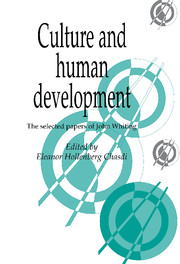Book contents
- Frontmatter
- Contents
- List of figures
- Preface
- Acknowledgments
- Introduction: John Whiting and anthropology
- Fifty years as a behavioral scientist: autobiographical notes
- Part I Theory and methods
- Part II Environment and history
- Introduction
- 4 Environmental constraints on infant care practices
- 5 The learning of values
- Part III Moral development
- Part IV Gender development
- Part V Development of social behavior
- Bibliography
- Complete bibliography of John W. M. Whiting's work
- Index
4 - Environmental constraints on infant care practices
Published online by Cambridge University Press: 23 December 2009
- Frontmatter
- Contents
- List of figures
- Preface
- Acknowledgments
- Introduction: John Whiting and anthropology
- Fifty years as a behavioral scientist: autobiographical notes
- Part I Theory and methods
- Part II Environment and history
- Introduction
- 4 Environmental constraints on infant care practices
- 5 The learning of values
- Part III Moral development
- Part IV Gender development
- Part V Development of social behavior
- Bibliography
- Complete bibliography of John W. M. Whiting's work
- Index
Summary
This article deals with the first two steps in the model for psychocultural research described in the previous selection (J. Whiting 1973). The steps can be summarized as follows:
Features in the history of any society and in the natural environment in which it is situated influence
the customary methods by which infants are cared for in that society, which have
enduring psychological and physiological effects on the members of that society, which are manifested in
the cultural projective–expressive systems of the society and the physiques of its members.
This chapter will focus on a detailed exploration of the variations in infant care by region, an analysis of the way in which they are patterned and how they are constrained by climate. The following world tour through the ethnographic reports describing infant care practices will make more meaningful the scales to be used in the formal analysis.
In Africa, infants after the lying-in period and before they become active toddlers spend most of their waking hours during the day on someone's back – usually the mother's, sometimes an older sister's. They are held in place by a shawl or animal skin, the ends of which are either passed diagonally over one of the carrier's shoulders and tied in front or passed under both arms and tied above the mother's breasts. The former method permits the infant to be brought around to the side to be held astride the carrier's hip rather than on the back.
- Type
- Chapter
- Information
- Culture and Human DevelopmentThe Selected Papers of John Whiting, pp. 107 - 134Publisher: Cambridge University PressPrint publication year: 1993
- 1
- Cited by



